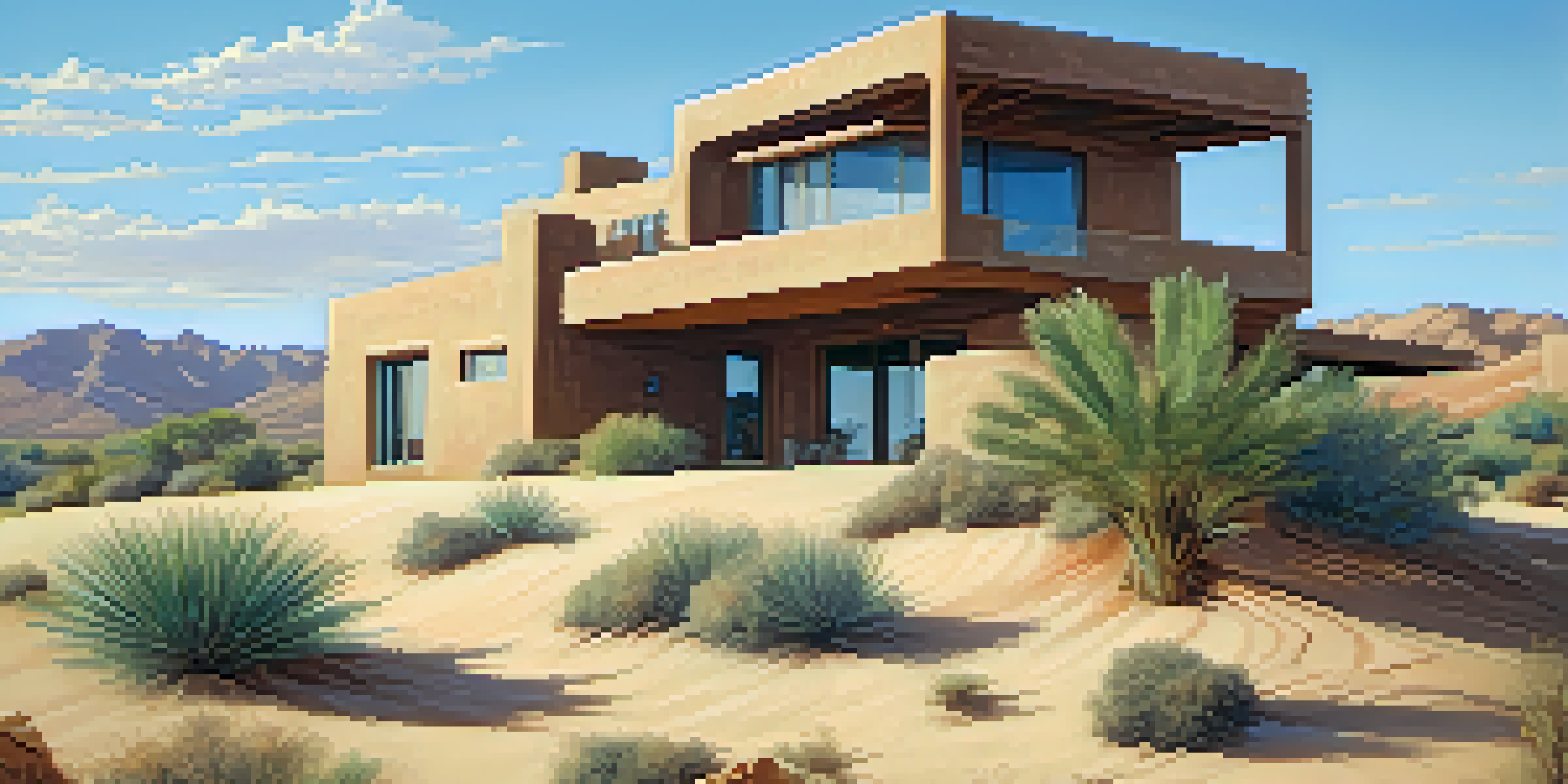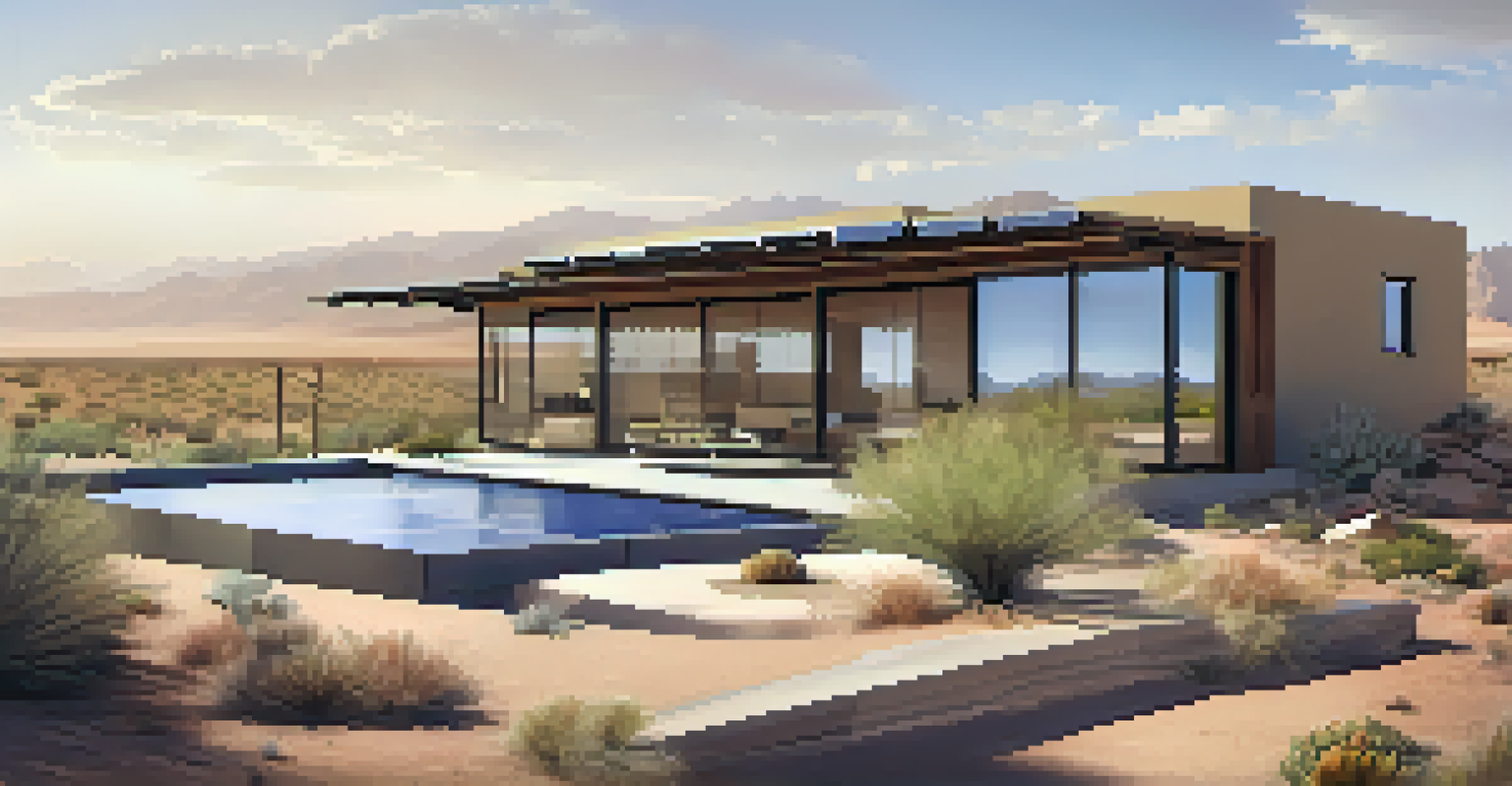Understanding the Principles of Desert-Inspired Architecture

The Essence of Desert-Inspired Architecture
Desert-inspired architecture embodies more than just aesthetics; it reflects a deep understanding of the environment. This architectural style is characterized by its ability to blend seamlessly with the arid landscape, utilizing materials and designs that respect the natural surroundings. By embracing local traditions and climate considerations, these structures become a part of their environment rather than an intrusion upon it.
Architecture is the learned game, correct and magnificent, of forms assembled in the light.
For example, buildings in desert regions often use earth-toned materials that mimic the surrounding landscape, enhancing their visual appeal. Additionally, the architecture often features flat roofs and thick walls, which help regulate internal temperatures, making them more comfortable without relying heavily on artificial cooling systems. This harmonious relationship between structure and nature is essential in desert architecture.
Ultimately, the essence of desert-inspired architecture lies in its functionality and respect for the land. By considering the unique conditions of the desert, architects create spaces that are not only beautiful but also sustainable, ensuring they remain relevant for generations to come.
Climate Considerations in Design
One of the most critical aspects of desert-inspired architecture is addressing the extreme climate conditions typical of arid regions. High temperatures during the day can be harsh, while nights may bring a significant drop in temperature. Architects must design buildings that protect inhabitants from these extremes while promoting comfort and efficiency.

To combat these challenges, many desert structures incorporate elements such as shaded outdoor spaces and strategically placed windows to maximize natural ventilation. Features like overhangs and awnings help block direct sunlight, keeping interiors cooler during the hottest parts of the day. This thoughtful design not only enhances comfort but also reduces the need for energy-intensive cooling systems.
Sustainable Design for Arid Climates
Desert-inspired architecture emphasizes sustainability through climate-responsive design, utilizing local materials and innovative techniques to create energy-efficient homes.
Moreover, the use of thermal mass materials, like adobe or stone, can help stabilize indoor temperatures by absorbing heat during the day and releasing it at night. Such strategic considerations are vital in desert architecture, showcasing how design can harmonize with the environment to create livable, sustainable spaces.
Utilizing Natural Materials and Resources
Natural materials play a pivotal role in desert-inspired architecture, providing both aesthetic and practical benefits. Materials such as adobe, rammed earth, and stone are not only abundant in desert regions but also possess excellent thermal properties. This makes them ideal for creating structures that are both beautiful and energy-efficient.
The best way to predict the future is to invent it.
Using local materials helps reduce the carbon footprint of construction, as there is less need for transportation and processing. Additionally, these materials often blend harmoniously with the surrounding landscape, enhancing the overall aesthetic appeal of the architecture. For instance, the warm hues of adobe walls can evoke a sense of connection to the earth and sky.
Moreover, incorporating natural resources like sunlight into design can lead to innovative solutions, such as passive solar heating. By strategically placing windows and openings, architects can harness natural light, reducing the need for artificial lighting and promoting a more sustainable lifestyle. This focus on natural materials and resources is a hallmark of desert-inspired architecture.
Sustainable Water Management Techniques
In desert regions, water scarcity is a significant concern, making sustainable water management techniques essential in architecture. Desert-inspired buildings often incorporate innovative strategies to collect and conserve water, ensuring a reliable supply for inhabitants. Rainwater harvesting and greywater recycling are common practices that help address this challenge.
For example, buildings may feature sloped roofs designed to direct rainwater into storage tanks, maximizing the use of precious rainfall. Similarly, greywater systems allow for the reuse of water from sinks and showers for irrigation, reducing waste and promoting sustainability. These techniques not only support the environment but also enhance the resilience of desert communities.
Emphasis on Outdoor Living Spaces
Creating functional outdoor areas enhances life in desert regions, allowing residents to enjoy nature while promoting community interactions and well-being.
By integrating sustainable water management practices into their designs, architects contribute to a more sustainable future. This commitment to responsible resource use highlights the adaptability and ingenuity of desert-inspired architecture, ensuring that it meets the unique challenges posed by arid climates.
Creating Outdoor Spaces for Living
Another essential principle of desert-inspired architecture is the emphasis on outdoor living spaces. Given the stunning landscapes and favorable weather conditions in many desert regions, creating functional outdoor areas can significantly enhance the living experience. These spaces serve as extensions of the home, promoting a lifestyle that embraces nature.
Patios, courtyards, and shaded terraces are common features in desert architecture, allowing residents to enjoy the outdoors while remaining protected from the sun. Thoughtful landscaping, including native plants and water features, can create inviting environments that connect people to their surroundings. This integration of indoor and outdoor spaces fosters a sense of community and well-being.
Moreover, outdoor spaces can facilitate social interactions and gatherings, making them an essential part of life in desert regions. By designing homes with these areas in mind, architects not only create a more enjoyable living experience but also encourage a deeper appreciation for the natural environment.
Cultural Influences on Design
Desert-inspired architecture is often deeply rooted in the cultural heritage of the region, reflecting the traditions and lifestyles of its inhabitants. This architectural style draws on local customs and practices, resulting in buildings that tell a story and resonate with the community. Understanding these cultural influences is crucial for creating meaningful designs.
For instance, many desert communities have a rich history of adobe construction, which is not only a practical choice but also a symbol of cultural identity. By incorporating traditional techniques and styles, architects can honor the past while addressing contemporary needs. This blend of old and new creates a sense of continuity and belonging for residents.
Cultural Heritage in Architecture
Desert architecture reflects the cultural heritage of its region, blending traditional practices with modern needs to foster a sense of identity and continuity.
Additionally, cultural influences can shape the aesthetics of desert architecture, from intricate tile work to vibrant colors. These elements add character and depth to structures, making them unique expressions of the local culture. By embracing cultural influences, desert-inspired architecture becomes a celebration of the region's heritage and identity.
The Future of Desert-Inspired Architecture
As climate change and urbanization continue to pose challenges, the future of desert-inspired architecture is more relevant than ever. Architects are increasingly prioritizing sustainability and resilience in their designs, ensuring that buildings can adapt to changing conditions. This focus on innovation will be essential for creating livable spaces in arid regions moving forward.
Emerging technologies, such as green building materials and smart home systems, offer exciting opportunities for enhancing desert architecture. These advancements can lead to more energy-efficient designs that reduce reliance on fossil fuels and promote a sustainable lifestyle. As a result, architects can create homes that are not only aesthetically pleasing but also environmentally responsible.

Furthermore, as awareness of the importance of climate-responsive design grows, we can expect to see a greater emphasis on community engagement in the architectural process. Involving local residents in design discussions can lead to solutions that truly reflect the needs and values of the community. The future of desert-inspired architecture promises to be a dynamic blend of tradition, innovation, and sustainability.